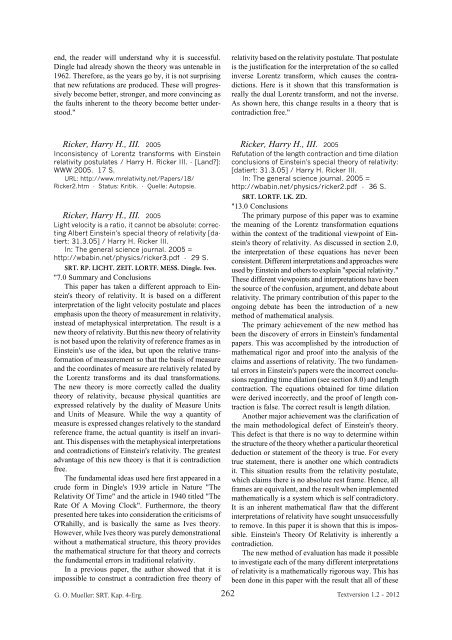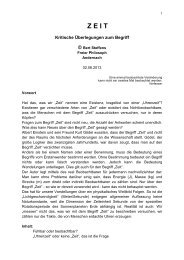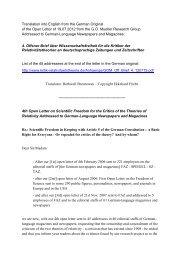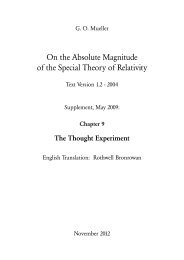2394 weitere kritische Veröffentlichungen - Kritische Stimmen zur ...
2394 weitere kritische Veröffentlichungen - Kritische Stimmen zur ...
2394 weitere kritische Veröffentlichungen - Kritische Stimmen zur ...
Sie wollen auch ein ePaper? Erhöhen Sie die Reichweite Ihrer Titel.
YUMPU macht aus Druck-PDFs automatisch weboptimierte ePaper, die Google liebt.
end, the reader will understand why it is successful.<br />
Dingle had already shown the theory was untenable in<br />
1962. Therefore, as the years go by, it is not surprising<br />
that new refutations are produced. These will progressively<br />
become better, stronger, and more convincing as<br />
the faults inherent to the theory become better understood."<br />
Ricker, Harry H., III. 2005<br />
Inconsistency of Lorentz transforms with Einstein<br />
relativity postulates / Harry H. Ricker III. - [Land?]:<br />
WWW 2005. 17 S.<br />
URL: http://www.mrelativity.net/Papers/18/<br />
Ricker2.htm - Status: Kritik. - Quelle: Autopsie.<br />
Ricker, Harry H., III. 2005<br />
Light velocity is a ratio, it cannot be absolute: correcting<br />
Albert Einstein's special theory of relativity [datiert:<br />
31.3.05] / Harry H. Ricker III.<br />
In: The general science journal. 2005 =<br />
http://wbabin.net/physics/ricker3.pdf - 29 S.<br />
SRT. RP. LICHT. ZEIT. LORTF. MESS. Dingle. Ives.<br />
"7.0 Summary and Conclusions<br />
This paper has taken a different approach to Einstein's<br />
theory of relativity. It is based on a different<br />
interpretation of the light velocity postulate and places<br />
emphasis upon the theory of measurement in relativity,<br />
instead of metaphysical interpretation. The result is a<br />
new theory of relativity. But this new theory of relativity<br />
is not based upon the relativity of reference frames as in<br />
Einstein's use of the idea, but upon the relative transformation<br />
of measurement so that the basis of measure<br />
and the coordinates of measure are relatively related by<br />
the Lorentz transforms and its dual transformations.<br />
The new theory is more correctly called the duality<br />
theory of relativity, because physical quantities are<br />
expressed relatively by the duality of Measure Units<br />
and Units of Measure. While the way a quantity of<br />
measure is expressed changes relatively to the standard<br />
reference frame, the actual quantity is itself an invariant.<br />
This dispenses with the metaphysical interpretations<br />
and contradictions of Einstein's relativity. The greatest<br />
advantage of this new theory is that it is contradiction<br />
free.<br />
The fundamental ideas used here first appeared in a<br />
crude form in Dingle's 1939 article in Nature "The<br />
Relativity Of Time" and the article in 1940 titled "The<br />
Rate Of A Moving Clock". Furthermore, the theory<br />
presented here takes into consideration the criticisms of<br />
O'Rahilly, and is basically the same as Ives theory.<br />
However, while Ives theory was purely demonstrational<br />
without a mathematical structure, this theory provides<br />
the mathematical structure for that theory and corrects<br />
the fundamental errors in traditional relativity.<br />
In a previous paper, the author showed that it is<br />
impossible to construct a contradiction free theory of<br />
G. O. Mueller: SRT. Kap. 4-Erg.<br />
262<br />
relativity based on the relativity postulate. That postulate<br />
is the justification for the interpretation of the so called<br />
inverse Lorentz transform, which causes the contradictions.<br />
Here is it shown that this transformation is<br />
really the dual Lorentz transform, and not the inverse.<br />
As shown here, this change results in a theory that is<br />
contradiction free."<br />
Ricker, Harry H., III. 2005<br />
Refutation of the length contraction and time dilation<br />
conclusions of Einstein's special theory of relativity:<br />
[datiert: 31.3.05] / Harry H. Ricker III.<br />
In: The general science journal. 2005 =<br />
http://wbabin.net/physics/ricker2.pdf - 36 S.<br />
SRT. LORTF. LK. ZD.<br />
"13.0 Conclusions<br />
The primary purpose of this paper was to examine<br />
the meaning of the Lorentz transformation equations<br />
within the context of the traditional viewpoint of Einstein's<br />
theory of relativity. As discussed in section 2.0,<br />
the interpretation of these equations has never been<br />
consistent. Different interpretations and approaches were<br />
used by Einstein and others to explain "special relativity."<br />
These different viewpoints and interpretations have been<br />
the source of the confusion, argument, and debate about<br />
relativity. The primary contribution of this paper to the<br />
ongoing debate has been the introduction of a new<br />
method of mathematical analysis.<br />
The primary achievement of the new method has<br />
been the discovery of errors in Einstein's fundamental<br />
papers. This was accomplished by the introduction of<br />
mathematical rigor and proof into the analysis of the<br />
claims and assertions of relativity. The two fundamental<br />
errors in Einstein's papers were the incorrect conclusions<br />
regarding time dilation (see section 8.0) and length<br />
contraction. The equations obtained for time dilation<br />
were derived incorrectly, and the proof of length contraction<br />
is false. The correct result is length dilation.<br />
Another major achievement was the clarification of<br />
the main methodological defect of Einstein's theory.<br />
This defect is that there is no way to determine within<br />
the structure of the theory whether a particular theoretical<br />
deduction or statement of the theory is true. For every<br />
true statement, there is another one which contradicts<br />
it. This situation results from the relativity postulate,<br />
which claims there is no absolute rest frame. Hence, all<br />
frames are equivalent, and the result when implemented<br />
mathematically is a system which is self contradictory.<br />
It is an inherent mathematical flaw that the different<br />
interpretations of relativity have sought unsuccessfully<br />
to remove. In this paper it is shown that this is impossible.<br />
Einstein's Theory Of Relativity is inherently a<br />
contradiction.<br />
The new method of evaluation has made it possible<br />
to investigate each of the many different interpretations<br />
of relativity is a mathematically rigorous way. This has<br />
been done in this paper with the result that all of these<br />
Textversion 1.2 - 2012





